Many Freemasons will have come across the phrase ‘riding the goat’, and will no doubt have been the butt of a joke about it (sorry, I couldn’t resist!) But what does it mean and where did the phrase come from?
An article on the Phoenix Masonry website, sheds light on the origins of the terminology:
The humorous idea that riding the goat constitutes a part of the ceremonies of initiation in a Masonic Lodge is just a Joke and has its real origin in the superstition of antiquity.
The old Greeks and Romans portrayed their mystical god Pan in horns and hoof and shaggy hide and called him goat-footed.
When the demonology of the classics was adopted and modified by the early Christians, Pan gave way to Satan, who naturally inherited his attributes; so that to the common mind the Devil was represented by a he-goat, and his best known marks were the horns, the beard, and the cloven hoofs.
Then came the witch stories of the Middle Ages, and the belief in the witch orgies, where, it was said, the Devil appeared riding on a goat.
These orgies of the witches, where, amid fearfully blasphemous ceremonies, they practiced initiation into their Satanic Rites, became, to the vulgar and illiterate, the type of the Masonic Mysteries; for, as Doctor Oliver says, it was in England a common belief that the Freemasons were accustomed in their Lodges “to raise the Devil.”
So the riding of the goat, which was believed to be practiced by the witches, was transferred to the Freemasons; and the sayings and jokes about it remain to this day, although the belief has long since died out.
The Lodge Goat and Goat Rides book above plays on the joke of riding the goat and plays on the humorous side of Lodge life.
There is a fascinating, more academic paper on the subject by William D. Moore entitled ‘Riding the Goat Secrecy, Masculinity, and Fraternal High Jinks in the United States, 1845–1930’, which you can read in full at http://phoenixmasonry.org/Moore_Riding_the_Goat.pdf
A similar, yet rather fanciful description was written in The New Age Magazine (a Masonic magazine published by the Supreme Council of the Thirty-Third Degree Ancient and Accepted Scottish Rite of Freemasonry for the Southern Jurisdiction of the United States) in 1913:
OUR FRIEND, THE GOAT PROBABLY no preconception of the Masonic initiation is more deeply founded in the mind of the candidate than that, at some period of the novitiate, he will be placed astride a large and woolly goat.
It was so with me and, from the time my petition went in until I first made alarm at the inner door of the preparation room, I frequently congratulated myself on the length of nether extremity with which Mother Nature had endowed me, thereby enhancing my chances of giving a creditable performance before the assembled brethren.
That this is the general view of the uninitiated is well-known, and the expression, “riding the goat”, is symbolic not only of Masonic initiations but of entrance to any of the large family of secret societies.
The origin of the expression is most interesting, not only as showing the connection of modern Masonry with the esoteric fraternities of the dim past, but also as showing how those ancient students drew allegory from the visible manifestations of the glorious works of our perpetual Grand Master.

Amon-ra [Amon] (L’esprit des quatre éléments, l’ame du monde matériel) Illustration by Léon-Jean-Joseph Dubois, Pantheon Egyptien, 1823
IMAGE LINKED: The New York Public Library Digital Collections. 1823 – 1825. Attribution 4.0 International (CC BY 4.0)
Great Ammon [Amun], the father of all the gods, was master of light, life, purity and-joy. His symbol was the sun. He alone reigned perpetually in heaven, surrounded by the souls of those mortals who had qualified for this reward by a blameless life on earth.
Typhon was the power of evil and at constant warfare with Ammon for possession not only of the souls of men but even for the rule of heaven itself. Ammon was surrounded by a pantheon of minor gods, not distinct and independent, but mere divisions of the attributes of the supreme god-head itself.
As moderns worship the Father, Son and Holy Ghost—the three in one— so the ancients subdivided the powers of Ammon and accorded to a lesser deity the rule over each particular power.
Khem was master of the life-giving principles for all created things, whether animal or vegetable, and was said to visit the earth in the form of a goat.
The myth has it that, during the Golden Age, when he was more worthy of the honor, the gods frequently left their celestial abode and mingled with man on the earth; that, on one such occasion, while they were feasting on the banks of the Nile, they saw approaching the dread Typhon, the terrible, whose abode was said to be the desert of Sahara.
To escape his onslaught the gods, led by Khem, plunged into the Nile and swam across to safety.
That part of the body of Khem which was beneath the waters turned into a fish, and in this form Ammon, in commemoration of the event, turned Khem into the constellation Capricornus—depicted in all books of astronomy to this day as a goat with the body of a fish—and made him perpetually one of the twelve signs of the zodiac.
His position in the heavens is near the extreme south, in fact the ancient astrologists styled Capricorn the South Gate of the Heavens.
The sun, the earthly symbol of Ammon, during the autumn months moves nearer and nearer to the South Gate as power wanes and, at the very lowest ebb of that power (the winter solstice of December 21st) comes in conjunction with the first point of the sign of Capricorn.
Here for six days he imbibes the life-giving and rejuvenating principles of Khem and then starts forth on his return journey, “riding the goat”, until he reaches the highest point in the heavens marked by the signs of Leo, whose strong grip is supposed to have elevated him to his full power of might and strength.
Even so, the candidate for Masonry, attacked by the powers of evil and with resistance at the lowest ebb, comes in contact with the goat and turns his face toward better things until the strong grip of the Lion elevates him to the full power and strength of perfect man- hood.
By a process of evolution the god Khem became Bacchus and, later, Pan of the Grecian mythology, but still retained his place in the zodiac and his earth-visiting form of the goat.
Pan is from a Greek word signifying “all things”, and relates to the life principle which animates all works of the Great Creator.
Pan was more particularly the god of the rural districts and loved to haunt the bosky dells and murmuring mountain streams, where his weird music chimed so harmoniously with the song of nature.
Then, when a mortal heard the pipes of Pan and felt the thrill of awe trickle from the roots of his hair to the ends of his toes, that mortal was said to be in a state of “panic”.
If the noise increased in volume and the mortal terror in proportion, it was said to be “pandemonium”, or “a devil of a panic”. Nowadays, under a like siege of imaginary terrors, the mortal would fearsomely look about him and say “that sure gets my goat”.
From the constellation of the zodiac and the apparent movements of the sun in its course was evolved the Osirian legend of the Egyptians which was the great-grandfather, we might call it, of another legend with which we are more familiar.
Osiris represented the sun and by a conspiracy of the twelve months he was slain and buried in the dead grass and leaves of the winter solstice.
His partial resurrection in April and May, as evidenced by the interspersed warm and cool days of those months, is symbolized by the two unsuccessful attempts of King Hiram, who later uses the strong grip of the Lion (the month of June in the ancient zodiac) with unqualified success, and thus we see the resurrected sun raised to its greatest height in the heavens on June 21 of each succeeding year.
Though it is in the sign of the Lion he attains his greatest perfection it was by contact with the sign of the Goat that he gained his first impulse to ascend and it was with the Goat that he left behind the burden of sin and evil which bound him amidst the rubbish of an ill-spent life, just as the Israelites of a later date bound their sins upon the back of a goat and drove it forth into the wilderness.
And so, I trust, it may be with us—that the goat which bore us into the full fellowship of the mystic tie has borne out with him all the vices and superfluities that hampered our career as a pro- fane, and that we may continue to gain eminence until, in time, we are fitted, as our friend, the Goat, for a perpetual place among the celestial constellations. Aegyptus.
Source: The New Age Magazine, vol. 18, 1913, pp378-9.
The Bucking Goat and the Fuzzy Wonder
However, the use of the phrase ‘riding the goat’ with regards to Freemasonry, stems from the late 19th/early 20th century practice by many fraternal societies of using bizarre contraptions manufactured by De Moulin Bros & Co, Illinois.
De Moulin produced paraphernalia and supplies for groups such as the Odd Fellows, or ‘Side-Degrees’.
The use of ‘the goat’, was just one of many ‘initiation’ activities deemed to be a bit of light-hearted fun – a form of hazing-lite!
These initiation ‘rituals’ or ‘trials’ became public knowledge, and so it was assumed that Freemasonry, as a fraternal – and supposedly secret – society, were using the same methods, ergo ‘riding the goat’ became synonymous with being a Mason.
Please note that these kind of activities – or hazing – have NEVER been used in bona fide Masonic lodges.

Cover of the 1930 edition of the DeMoulin Bros. & Co. catalogue ‘Burlesque and Side Degree Specialties, Paraphernalia and Costumes’.
IMAGE LINKED: Phoenix Masonry Masonic Museum
These mechanical or ‘goat-riding trikes’ were manufactured by De Moulin especially for Fraternal Societies, such as the Odd Fellows, Maccabees, and Shriners.

‘A little nonsense now and then is relished by the best of men’
A book entitled ‘The Lodge Goat: Goat Rides, Butts and Goat Hairs. Gathered from the Lodge Rooms of every Fraternal Order. More than a thousand anecdotes, incidents and illustrations from the Humorous Side of Lodge Life’ was written in 1902 by James Pettibone. It was a (slightly disturbing) insight into the shenanigans of Fraternal Societies, with just a hint of anti-Masonic sentiment.

Are you a Mason?
Soon the concept of ‘riding the goat’ supposedly associated with Masonry seeped into popular culture. One such example was a farcical comedy called ‘Are You A Mason?’ which appeared on Broadway in New York City in 1901.
The three act play by Leo Dietrichstein was playing in London, England, as late as 1911, it was adapted and translated from an original German farce, ‘Die Logenbrüder’ (The Freemason) by Carl Laufs and Curt Kratz.
The scenario of ‘Riding the Goat’ appeared in the script:
Eva (Wife) – Tell me dear, how did you get along?
Perry (Husband) – I missed you dreadfully.
Eva – No, no I mean with your Initiation. How did you get through?
Perry – First rate. It was all very solemn and impressive.
Eva – Now tell me, weren’t you just a wee bit frightened?
Perry – Frightened? Why should I be?
Eva – Well, I’ve been told they have a sort of chamber of horrors – full of skeletons and bones and skulls, with trap doors and secret passages – a procession of masked men with sharp pointed daggers – riding on black goats; but come on tell me all about it – I’m just dying to hear it all!
Perry – I am sorry, but we are pledged to inviolable secrecy! I will acknowledge one thing though – I got bow-legged riding the goats.
It was also more famously satirised in a series of Masonic postcards originating from the early 1900s. Among the most collectible are those entitled, ‘Are You A Mason?’
The first set of six cards were copyrighted by Irvin M. Kline in 1907. They were published by the Macoy Publishing Company, New York City.
They were originally printed in black and white with some sections coloured in yellow. Within a few years, identical pictures appeared in full colour, printed in Great Britain by the Millar and Lang company in their ‘National Series’.
The first six cards included:

These later versions included a whole host of images revolving around the theme of ‘goats’!

Postcard images via Phoenix Masonry – however, these images are variously in the public domain.
Bobby Bumps Starts a Lodge – a 1916 cartoon featuring ‘the goat’.
[Note: there are some cultural references of the era, which some viewers may find offensive]
Further Reading:
‘Riding the Goat Secrecy, Masculinity, and Fraternal High Jinks in the United States, 1845–1930’ – William D. Moore.
Abstract: The idea that candidates undergoing initiation into American fraternal groups were forced to ride goats was ubiquitous in the decades surrounding the beginning of the twentieth century.
In this period, Americans presented the lodge goat in literary, visual, and three‐dimensional manifestations. This interdisciplinary article charts the development and use of this fraternal symbol between 1845 and 1930.
It argues that the goat, originally wielded by the enemies of fraternalism to represent the dangers associated with secret behavior, came to be embraced and celebrated by fraternalists and that the animal’s meaning shifted as concepts of American masculinity were transformed.
Copyright: ©2007 by The Henry Francis du Pont Winterthur Museum, Inc. All rights reserved. Winterthur Portfolio, Volume 41, Number 2/3Summer/Autumn 2007. https://www.journals.uchicago.edu/doi/10.1086/518920
The Freemasons for Dummies Blog has a great article which covers all this and more on the subject of ‘the goat’.

The Lodge Goat
by James Pettibone (Author)
Excerpt from The Lodge Goat: Goat Rides, Butts and Goat Hairs, Gathered From the Lodge Rooms of Every Fraternal Order; More Than a Thousand Anecdotes, Incidents and Illustrations From the Humorous Side of Lodge Life
MY dear reader, – In appearing before you under the cover of this book, and exposing to profane view a few of the profound secrets of a long and eventful career in connection with the Lodges of various Secret Fraternities, I feel I can safely do so without incurring the disapproval of my F raters, and that I shall be greeted with their cordial and unqualified indorsement instead.
In this intrusion upon a general public, I am sure I shall meet, and renew the acquaintance of, a host of old and valued friends, with recollections of past associations and of agreeable intercourse, which none of us can forget, nor do we regret.
About the Publisher
Forgotten Books publishes hundreds of thousands of rare and classic books. Find more at www.forgottenbooks.com
This book is a reproduction of an important historical work. Forgotten Books uses state-of-the-art technology to digitally reconstruct the work, preserving the original format whilst repairing imperfections present in the aged copy.
In rare cases, an imperfection in the original, such as a blemish or missing page, may be replicated in our edition.
We do, however, repair the vast majority of imperfections successfully; any imperfections that remain are intentionally left to preserve the state of such historical works.
Recent Articles: Masonic Miscellanies
 Masonic Miscellanies - The Amulet of the Ladder Explore the cosmic significance of the Ladder in ancient Egyptian mythology through Wallis Budge's "Egyptian Magic." Discover how this profound symbol bridges the mortal and divine, encapsulating the Egyptians' fervent afterlife aspirations with a blend of myth, magic, and material culture. Dive into the celestial ascent of Osiris and mortal souls. |
 Masonic Miscellanies - Adulterine Gilds Guilds, the associations that shaped medieval European society, were more than just organizations of artisans and merchants. They played a vital role in the economic and social development of towns and cities. This exploration delves into the intriguing concept of adulterine gilds and their interconnectedness with guilds, offering insight into the significance of legal authorization and recognition in medieval Europe. |
 Masonic Miscellanies - Masonic Orb Discover the fascinating world of Masonic ball watch fobs, intricately crafted with tiny pyramids that form a cross when opened. These decorative accessories were all the rage in the late 1800s and early 1900s, and they still hold a certain allure today. Explore the different varieties and symbols found on these unique pieces that carry deep Masonic meaning. |
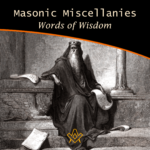 Masonic Miscellanies – Words of Wisdom Uncover timeless wisdom from King Solomon to Albert Pike in our latest Masonic Miscellanies, a treasure trove of insights for Masons. Journey through the ages and glean inspiring sayings, reflecting on their profound influence on Masonic principles. An enriching read for the enlightened. |
 Masonic Miscellanies - Symbolism of the Right Hand Unlock the enigmatic realm of Freemasonry as we delve into its age-old symbols, rituals, and philosophies. This thought-provoking exploration, drawn from Mackey's Revised Encyclopedia of Freemasonry, focuses on the iconic 'right hand' symbol - its rich history, universality, and profound significance. |
 Masonic Miscellanies - Order of the Secret Monitor Unveil the mystery of Freemasonry with 'The Order of the Secret Monitor'. Discover this lesser-known appendant order, its unique rituals, and the profound teachings it offers. Explore the bonds of friendship and brotherhood it fosters, all wrapped in an intriguing cloak of mystery. Your journey into the depths of Masonic wisdom begins here. |
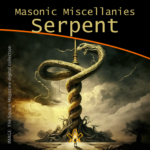 Masonic Miscellanies - The Symbol of the Serpent As a symbol, the serpent obtained a prominent place in all the ancient initiations and religions. |
 Masonic Miscellanies - The Four Veils in Royal Arch Masonry What are the four veils in Royal Arch Masonry? And what is the 'Ceremony of Passing the Veils'? Although common throughout Scotland, Ireland and the United States, it is mostly unknown in England, presently only worked in the Province of Bristol. ( and by dispensation ) |
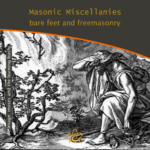 Masonic Miscellanies - Bare feet and Freemasonry A candidate for initiation into a Masonic Lodge often finds the requirements which he/she must fulfil somewhat odd. The mode of preparation often remains a puzzle, since the ritualistic explanation is not offered in full. Why are we 'slipshod' or "bare-footed" in Masonic Ritual? |
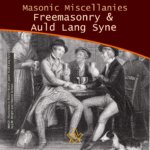 Masonic Miscellanies – Freemasonry and Auld Lang Syne Millions of people throughout the world will sing Auld Lang Syne to see out the Old Year. Few will know all the words, fewer still know what they mean, or that there is a link to Freemasonry. |
 Masonic Miscellanies - The Mosaic Pavement - why mosaic, why pavement? We are all familiar with the black and white chequered flooring of the Masonic lodge but where did it originate? There are a few theories… |
 Masonic Miscellanies – Masonic Master's Carpets Have you got a magic "Masonic Master's Carpet" in your lodge? I say 'magic' with my tongue firmly in my cheek because (as far as I know) these fabulous works of art don't bestow any mystical powers but can bestow some educational ones! However, considering their possible value today, they may magic up some interest (or funds). |
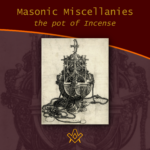 Masonic Miscellanies – The Pot of Incense Just when the pot of incense became an emblem of the third section of the Sublime Degree can not be stated with certainty. It is, apparently, an American invention or addition. But what does it symbolise? |
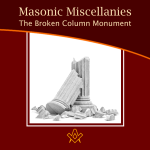 Masonic Miscellanies - The Broken Column Monument The story of the broken column was first illustrated by Amos Doolittle in the "True Masonic Chart" by Jeremy Cross, published in 1819. |
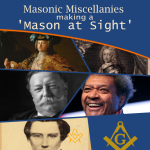 Masonic Miscellanies - Making a 'Mason at Sight' What does it mean to make a 'Mason at sight', and who was made one? |
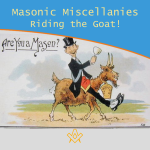 Masonic Miscellanies - Riding the Goat! Many Freemasons will have come across the phrase 'riding the goat', and will no doubt have been the butt of a joke about it (sorry, I couldn't resist!) But what does it mean and where did the phrase come from? |
 Masonic Miscellanies - What are the 'three dots'? Three dots or points in an upright triangular shape ∴ is most commonly known as the 'therefore' sign – so why is it used in Freemasonry? |
 Masonic Miscellanies - Keep Within Compass This month we discover a series of allegorical prints warning us to "Keep within Compass and you shall be sure, to avoid many troubles which others endure." |
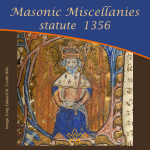 Masonic Miscellanies - statute 1356 Further to the reference in the article – The Builders - 6 - Free-Masons 'a statute was enacted against the Free-masons in 1356' – Regulations for masons who are hewers, on the one hand, and the light masons and setters on the other. |
 Masonic Miscellanies - An Anti-Masonic 'Apron'? The Anti-Masonic 'Apron' was created during the 1832 Presidential election in USA. It was not Ani-masonic. And it was not an apron. Read on to find out what and why it was created. |
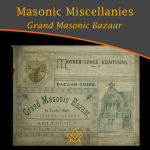 Masonic Miscellanies - Grand Masonic Bazaar (1895) Grand Masonic Bazaar (1895); to raise funds to clear the debt incurred by “Mother Kilwinning” in rebuilding their Lodge. |
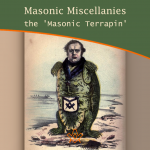 Masonic Miscellanies - the 'Masonic Terrapin' A satirical book from 1851 includes a bizarre caricature of a 'Masonic Terrapin' - all I can say is 'read on'… |
 Masonic Miscellanies - Masonic Bookplates You probably know what a bookplate is for, but did you know that the earliest known book mark/label dates from the reign of Amenhotep III in Egypt around 1391−1353 BCE?! |
 Masonic Miscellanies - Freemasonry & Bees Freemasonry & Bees - what's the buzz? The bee was among the Egyptians the symbol of an obedient people, because, says Horapollo, of all insects, the bee alone had a king. |
 Masonic Miscellanies - The mystery of the Tattooed Freemason In 1894, the body of a drowned man was found in the Bay of San Francisco - what they discovered was amazing. |
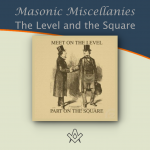 Masonic Miscellanies - The Level and the Square (A Poem) The Level and the Square (A Poem) - "We meet upon the Level, and we part upon the Square – |
 Masonic Miscellanies - The Mystic Tie What is the 'Mystic Tie'? Clue: it's not an item of neckwear! |
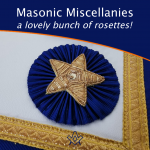 Masonic Miscellanies - A lovely bunch of rosettes! Where did the origin of the use of rosettes on Masonic aprons come from ? |
 Masonic Miscellanies - The Lodge of Sorrow The Lodge of Sorrow - Extracted General Ahiman Rezon, by Daniel Sickles, [1868] |
 Masonic Miscellanies - Memento Mori Memento Mori - a Masonic reminder to make your mark on the world |
 Masonic Miscellanies - A closer look at the Level and the Plumb-rule A closer look at the Level and the Plumb-rule |
 Masonic Miscellanies - The Symbolism of the Gloves The Symbolism of the Gloves and why Freemasons wear white gloves |
 Masonic Miscellanies - Will the real James Anderson please stand up? Will the real James Anderson please stand up? |
 Masonic Miscellanies - The Legend of the Third Degree The most important and significant of the legendary symbols of Freemasonry is, undoubtedly, that which relates to the fate of Hiram Abif. |
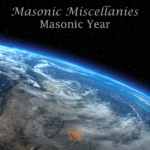 Masonic Miscellanies - Masonic Calendar Why do Freemasons use different 'years' to our regular calendar? |
 Masonic Miscellanies - What is a 'Lewis'? The English word 'Lewis' is a term belonging to operative Masonry, and signifies an iron cramp, which is inserted in a cavity prepared for the purpose in a large stone. |
 Masonic Miscellanies - From J.S.M. Ward Ever wondered why masons had to be 'free' or why we have a Tyler? |
masonic knowledge
to be a better citizen of the world
share the square with two brothers

click image to open email app on mobile device









